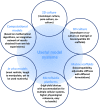Mechanobiology of Cancer Stem Cells and Their Niche
- PMID: 31004332
- PMCID: PMC6529500
- DOI: 10.1007/s12307-019-00222-4
Mechanobiology of Cancer Stem Cells and Their Niche
Abstract
Though the existence of cancer stem cells remained enigmatic initially, over the time their participation in tumorigenesis and tumor progression has become highly evident. Today, they are also appreciated as the causal element for tumor heterogeneity and drug-resistance. Cancer stem cells activate a set of molecular pathways some of which are triggered by the unique mechanical properties of the tumor tissue stroma. A relatively new field called mechanobiology has emerged, which aims to critically evaluate the mechanical properties associated with biological events like tissue morphogenesis, cell-cell or cell-matrix interactions, cellular migration and also the development and progression of cancer. Development of more realistic model systems and biophysical instrumentation for observation and manipulation of cell-dynamics in real-time has invoked a hope for some novel therapeutic modalities against cancer in the future. This review discusses the fundamental concepts of cancer stem cells from an intriguing viewpoint of mechanobiology and some important breakthroughs to date.
Keywords: Mechanotransduction; Niche; Stem cells; Stiffness; Stromal remodeling.
Conflict of interest statement
The authors declare no competing interests.
Figures



Similar articles
-
The matrix environmental and cell mechanical properties regulate cell migration and contribute to the invasive phenotype of cancer cells.Rep Prog Phys. 2019 Jun;82(6):064602. doi: 10.1088/1361-6633/ab1628. Epub 2019 Apr 4. Rep Prog Phys. 2019. PMID: 30947151 Review.
-
Steering cell behavior through mechanobiology in 3D: A regenerative medicine perspective.Biomaterials. 2021 Jan;268:120572. doi: 10.1016/j.biomaterials.2020.120572. Epub 2020 Nov 25. Biomaterials. 2021. PMID: 33285439 Review.
-
Stem Cell Mechanobiology and the Role of Biomaterials in Governing Mechanotransduction and Matrix Production for Tissue Regeneration.Front Bioeng Biotechnol. 2020 Dec 14;8:597661. doi: 10.3389/fbioe.2020.597661. eCollection 2020. Front Bioeng Biotechnol. 2020. PMID: 33381498 Free PMC article. Review.
-
Mechanobiology in cardiac mechanics.Biophys Rev. 2021 Aug 27;13(5):583-585. doi: 10.1007/s12551-021-00827-4. eCollection 2021 Oct. Biophys Rev. 2021. PMID: 34765042 Free PMC article.
-
Extracellular matrix type modulates mechanotransduction of stem cells.Acta Biomater. 2019 Sep 15;96:310-320. doi: 10.1016/j.actbio.2019.06.048. Epub 2019 Jun 28. Acta Biomater. 2019. PMID: 31255664 Free PMC article.
Cited by
-
Integrating the Tumor Microenvironment into Cancer Therapy.Cancers (Basel). 2020 Jun 24;12(6):1677. doi: 10.3390/cancers12061677. Cancers (Basel). 2020. PMID: 32599891 Free PMC article. Review.
-
The Role of Cancer Stem Cells and Mechanical Forces in Ovarian Cancer Metastasis.Cancers (Basel). 2019 Jul 18;11(7):1008. doi: 10.3390/cancers11071008. Cancers (Basel). 2019. PMID: 31323899 Free PMC article. Review.
-
Cancer Stem Cell Plasticity - A Deadly Deal.Front Mol Biosci. 2020 Apr 30;7:79. doi: 10.3389/fmolb.2020.00079. eCollection 2020. Front Mol Biosci. 2020. PMID: 32426371 Free PMC article. Review.
-
Proposal to Consider Chemical/Physical Microenvironment as a New Therapeutic Off-Target Approach.Pharmaceutics. 2022 Sep 29;14(10):2084. doi: 10.3390/pharmaceutics14102084. Pharmaceutics. 2022. PMID: 36297518 Free PMC article.
-
Identification of phenotype-specific networks from paired gene expression-cell shape imaging data.Genome Res. 2022 Apr;32(4):750-765. doi: 10.1101/gr.276059.121. Epub 2022 Feb 23. Genome Res. 2022. PMID: 35197309 Free PMC article.
References
-
- Zhang J, Li L. Stem cell niche: microenvironment and beyond. J Biol Chem. 2008;283(15):9499–9503. - PubMed
-
- Clarke MF, Dick JE, Dirks PB, et al. Cancer stem cells—perspectives on current status and future directions: AACR workshop on cancer stem cells. Cancer Res. 2006;66:9339–9344. - PubMed
-
- Paszek MJ, Zahir N, Johnson KR, et al. Tensional homeostasis and the malignant phenotype. Cancer Cell. 2005;8(3):241–254. - PubMed
Publication types
Grants and funding
LinkOut - more resources
Full Text Sources

